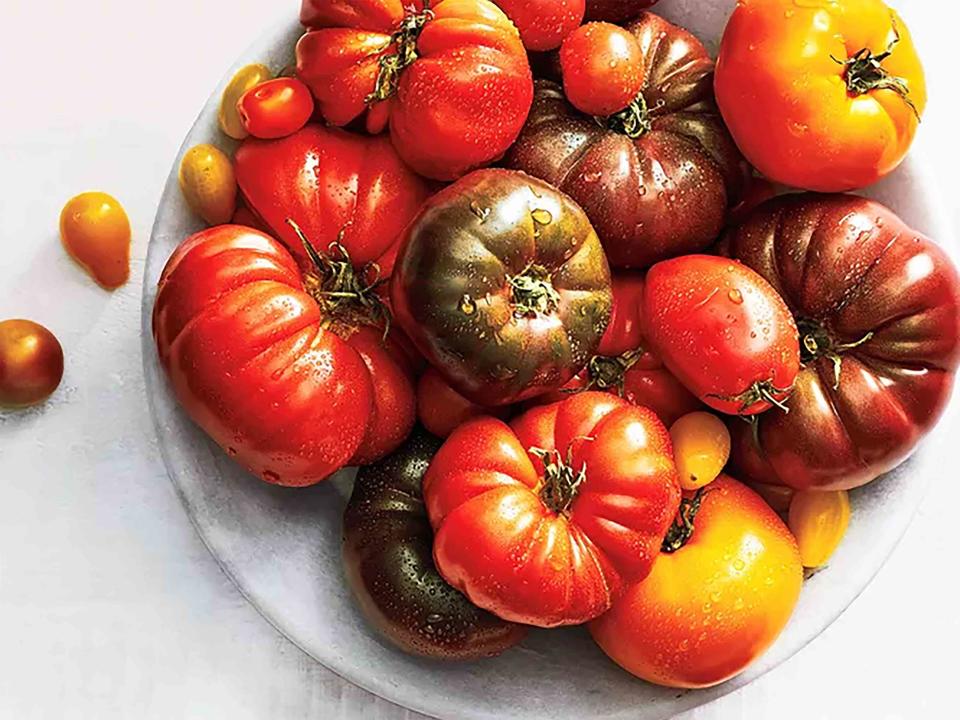I Asked 3 Farmers for the Best Way to Store Tomatoes—This Is the Step You Should Never Skip
The small move makes a big difference.

GREG DUPREE/MEREDITH
If only our favorite produce were like our clothing and came with tags that list detailed care instructions. Instead of “machine wash cold; lay flat to dry,” the directive might be “store in the crisper drawer; wash just prior to use.”
Alas, fresh fruits and vegetables don’t come with such helpful advice, nor can tell us how they like to be treated, so it’s up to us—as the lucky ones who get to enjoy them—to study up on how best to store them. Instructions vary widely. Some items benefit from cool storage, while others wilt in the fridge (ahem, fresh basil). A few are fine to wash in advance and store, but most last the longest when you skip the washing until you’re ready to savor the fruits (or vegetables) of your labor.
Since we’re in the heart of fresh tomato season, which spans May to October in most parts of the U.S., we thought it was high time to brush up on how to store tomatoes. This time, we decided to go directly to the source: the people who grow them. Here's what three farmers had to say.
Meet the Farmers
Farmer Lee Jones, a regenerative farmer and the founder of The Chef Garden in Huron, Ohio
Dana Peters, a Barney, Georgia-based produce and floral field inspector at Whole Foods Market (who grew up on a small family farm)
Jerrold Watson, co-owner of Watsonia Farms in Monetta, South Carolina
The Best Way to Store Tomatoes, According to Farmers
The ripeness level and the type of tomato dictate the best place and conditions for tomato storage, but as a general rule, all three farmers agree that “tomatoes should be stored at room temperature, away from direct sunlight. This preserves their flavor and texture,” summarizes Jones.
Unripe tomatoes should be kept at room temperature to ripen. Unless you want tomatoes to ripen faster, “store tomatoes at a distance from any ethylene-producing items, such as apples or bananas, which would accelerate the ripening process,” says Peters.
Ethylene is a gas that’s naturally emitted by certain fruits and vegetables, like avocados, kiwi, and peaches (tomatoes themselves are also ethylene-releasers). Ethylene exposure speeds up the ripening process, especially for produce that’s particularly ethylene-sensitive. While tomatoes aren’t as impacted by ethylene as fruits like avocados, bananas, grapes, and peppers, research suggests that tomatoes will still ripen at a more rapid pace if they’re in the proximity of ample ethylene producers.
Once ripe, tomatoes can be eaten immediately or stored following these pro tips from Peters:
Store tomatoes stem-side down. We were blown away by this simple yet brilliant strategy. Turns out, flipping the tomatoes over decreases the airflow to the stem. As a result, there’s less potential contact with mold, bacteria, or other contaminants that could speed up spoilage. Plus, tomatoes tend to stay juicier longer when stored upside-down.
Place them on a dry kitchen counter in the coolest part of the kitchen. “The ideal storage temperature for tomatoes is between 55 and 70 degrees F, but the temperature of most refrigerators is closer to 40 degrees F,” Peters says. “A fully ripe tomato can go into the refrigerator for a day or two and still eat well, but before eating, the tomato should be brought back to room temperature. An underripe tomato will never improve with refrigeration.”
The Worst Way to Store Tomatoes
That latter tip leads naturally to the worst way to store tomatoes: “In the refrigerator. This makes them tasteless,” explains Jerrold Watson, co-owner of Watsonia Farms in Monetta, South Carolina.
Beyond stripping away the fresh, sweet-tart flavor, refrigeration can also lead to a mealy texture. The only time you should refrigerate tomatoes is after they’re cut. This is a must to prevent bacterial growth. If you’ve cut tomatoes and exposed the flesh, but don’t plan to finish them, transfer the tomatoes to an airtight food storage container, refrigerate, and aim to polish them off ASAP.
How Long Do Fresh Tomatoes Last?
Again, the lifespan of a tomato depends on the variety and how ripe it was when you acquired it. If you harvested the tomatoes fresh from your garden or scored them at a farmers market stand that picked them the day prior, the farmers agree that the fresh tomatoes typically last about seven days. Check in on the tomatoes once per day to check for ripeness—and to ensure that none are leaking juices or showing signs of mold.
If you can’t make it through your fresh tomatoes in a week, consider canning or freezing the tomatoes to preserve one of summer’s best fruits to enjoy up to eight months (frozen) to 12 months (canned) later.
How to Enjoy Fresh Tomatoes, Farmer-Style
The best tomato recipes are the simplest: “I prefer to enjoy fresh tomatoes, straight from the vine with a handkerchief in one hand and a tomato in the other,” Jones says. (Summer at its best!)
As for Watson and Peters, they prefer fresh tomatoes in salads and sandwiches. “My favorite way to enjoy a fully-ripened tomato is sliced and served as part of a bacon, tomato, and cheese sandwich,” Peters says.
Craving more tomato recipe inspiration to make the most of your bounty? Our home cooks can’t get enough of the World's Best Pasta Sauce!, Balsamic Bruschetta, Cucumber Tomato Salad, Fresh Tomato Soup, Panzanella Salad, and Chef John's Tomato Tart.
Read the original article on All Recipes.


